Pentagon Lies and Afghan Civilian Deaths: The Unspoken Truth
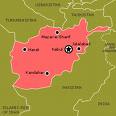
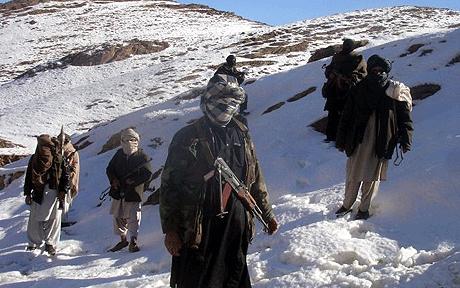
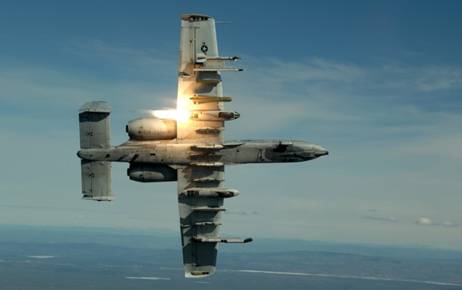
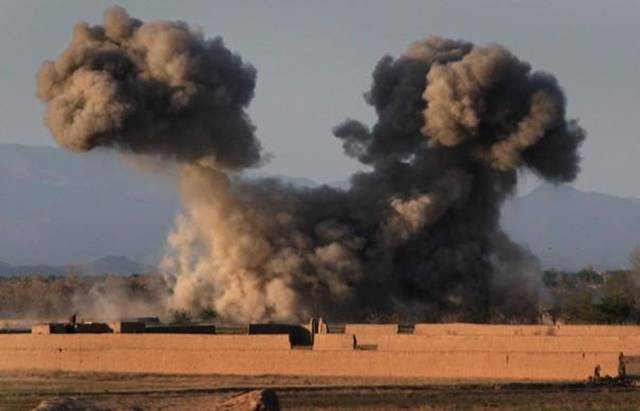
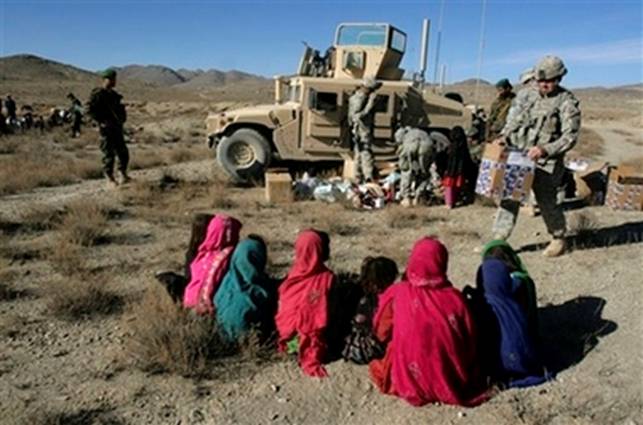
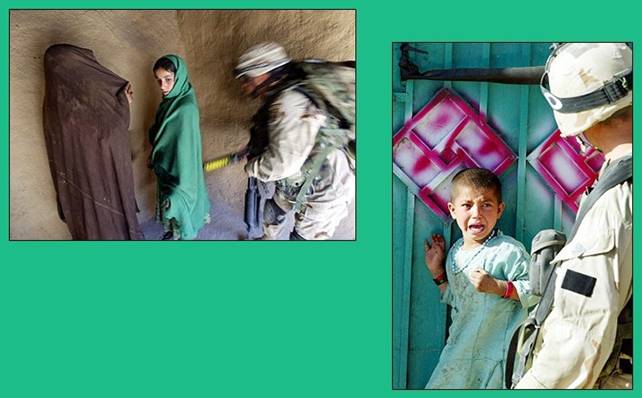
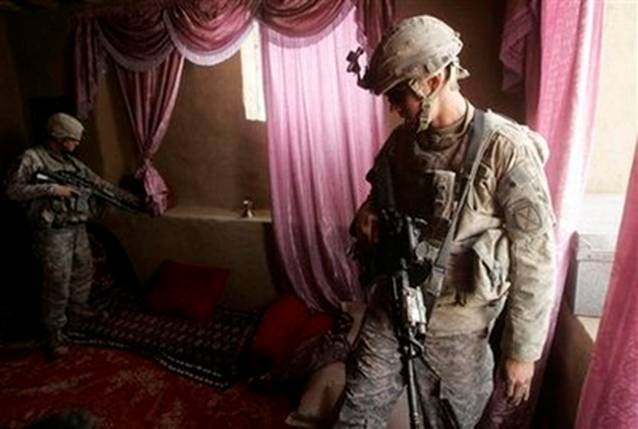
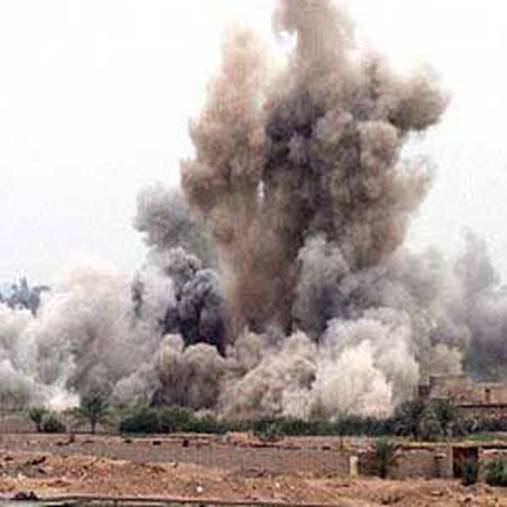
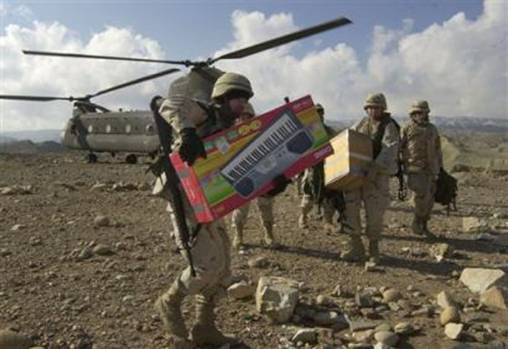
Sources: Taliban fighters at http://blogs.telegraph.co.uk/news/praveenswami/100064208/in-afghanistan-the-jihadists-talking-peace-aren%E2%80%99t-the-ones-making-war/
and an A-10 Warthog of the U.S Air Force http://www.wired.com/dangerroom/2010/11/bombs-away-afghan-air-war-peaks-with-1000-strikes-in-october/
and deadly strike by a US Navy F-18 on April 3, 2009 on Now Zad,
“From the sky, occupation forces are bombing, killing civilians – mostly women and children. On the ground, Taliban and warlords together continue their fascism. The US and NATO occupy my country under the name of all beautiful banners of democracy, women’s rights, human rights. And for this long time, they shed the blood of our people under the name of war on terror……. It’s better [for the US and NATO] to leave Afghanistan, then it’s much easier for us to fight one enemy instead of two” – Malalai Joya, November 11, 2010 at http://www.towardfreedom.com/home/middle-east/2178-why-the-us-should-leave-afghanistan-an-interview-with-malalai-joya-former-afghan-member-of-parliament.
Introduction: November 30, 2001 in Afghanistan
Let me begin with the unreported news from the ground in Afghanistan exactly nine years ago, that is on November 30, 2001.
The relentless U.S aerial bombing and strafing of the Kandahar area in late November and early December 2001 led to dozens, if not hundreds, of innocent civilians dying. People fled in every type of vehicle – trucks, minibuses, taxis, cars, tractors with trailers, etc. U.S. aircraft were hitting vehicles which dared to leave Kandahar. One resident of Kandahar said on Saturday, December 1st,
“It’s just like Armageddon. The people are in a terrible situation whether they stay or go.”
Another man, Khalil Ahmed added,
“In the last 24 hours, barely five minutes have gone by without a bomb dropping.”
The United Nations estimated that 2,000 people a day were fleeing Kandahar towards Pakistan. Ansar Burney, head of the Pakistani welfare trust of the same name, described seeing hundreds of disheveled, frightened, dazed families fleeing towards the border. Mr. Burney said,
“Some people were too weak to walk and just stopped. Whole families were walking together, just carrying a few belongings. The children were crying. Everybody was hungry and thirsty. I have never seen anything like it.”
At the border camp in Chaman, veiled women squatted in the sand, waiting for medical treatment. Each had her own story of misery to relate:
“Zabulnar, clutching her sick six-month-old daughter Zara, lost her grandfather and a cousin when a bomb hit their house in Kandahar city at night. A 35-year-old woman lost her husband and 18-year-old son five days ago…‘I went out of the house and then heard this enormous sound…then part of it was not there. My husband and son were just gone…there were some Taliban around the village but not so close. I don’t know why the Americans bombed us.’”
Fatima’s home was hit about midnight, killing her two sons instantly. She too fled to Chaman with her 6 grandchildren.
Refugees trying to escape the relentless U.S bombing of Kandahar sought to flee on tractors and became victims as American war planes bombed the moving tractors. Hamdullah who arrived in Chaman on Tuesday said, “Yesterday I saw two tractors towing trailers which were lying on their side. They both had been carrying families or refugees who were trying to get away from the city. There were no survivors.
The nameless victims died on a road just outside Kandahar.
A father brought his son to the Chaman hospital, wounded by shrapnel, after a U.S bomb had fallen at daybreak next to his 13 year-old son working in a field.
The families of Noor Mohammed, 57, and Abdul Ghafur had fled the tiny farming hamlet of Mohammed Khan Kalatcha, about 12 miles southwest of Kandahar, comprising six adobe houses and 116 inhabitants. The village had begun being bombed at 10 p.m. on November 30th with bombs falling on the vineyards and pomegranate trees. The following morning, the villagers saw fifty yellow BLU-97 cluster bomblets. The two families decided to flee and boarded the tractor and trailer at 7 a.m. At about 9 a.m. it was rumbling over a bumpy road in the middle of a flat, desolate expanse of barren desert. It was clear and sunny. A U.S plane appeared and flew over at a high altitude, then dipped lower, dropped a bomb which landed 15 feet from the tractor, circled again, and obviously fired a missile. The huge explosion killed 8 civilians instantly. A survivor recounts,
“I didn’t realize what had happened. My mother’s head was cut off. It was like a slaughter. My sister was killed and the trailer was full of blood.”
Reporting for Canadian Press, Stephen Thorne wrote about the U.S. attack,
“it was the 15th day of Ramadan….when American aircraft rained seeds of despair on this tiny agricultural village south of Kandahar. They came at night like dandelion seeds blowing in the wind, yellow cluster bombs about the size of pop cans drifting down beneath little parachutes onto the clay buildings, the fields surrounding them, the orchards beside them. The villagers ran from their homes, but the high clay walls that keep out the dry desert winds couldn’t stop the blasts, intended for a Taliban compound about half a kilometer up a narrow dirt road in an area speckled with destroyed tanks and equipment.” Noor Mohammed lost five family members (his wife, 2 sons, 2 daughters) and Abdul Ghafur lost his wife, brother and sister, when a U.S warplane attacked their tractor convoy with 20 people aboard near Haji Mohammed Khan Kalatcha village, south of Kandahar near the airport.”
Gul Ahmed, resident of Kandahar, saw trucks full of food which had been hit by U.S warplanes on the road between Spin Boldak and Kandahar,
“They attacked six loading trucks carrying wheat flower. I saw all the flour bags were burned as were the vehicles.”
Another victim said he had seen the wreckage of five vehicles on that road – two minibuses, one car and two trucks. Aminullah said his son Saifullah had been working in the fields on the outskirts of Kandahar at daybreak, when a large U.S. bomb exploded next to him. U.S. shrapnel sliced both of Saifullah’s legs.
The following tombstones come from my Afghan Victim Memorial Project:
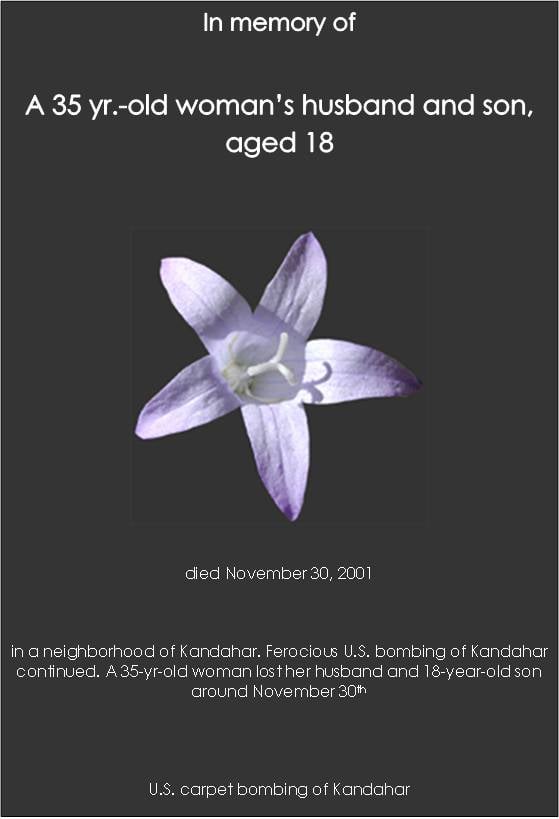
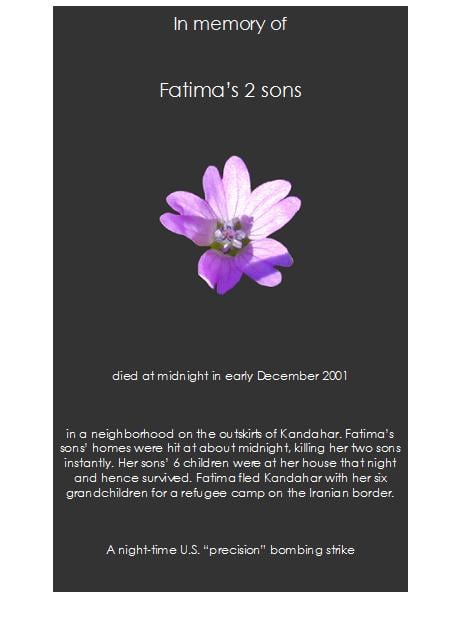
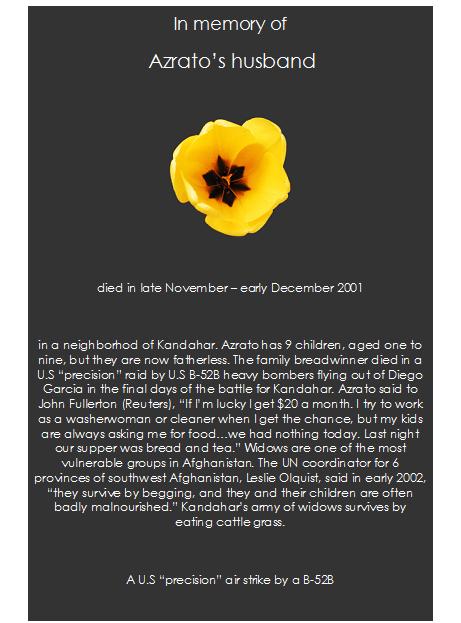
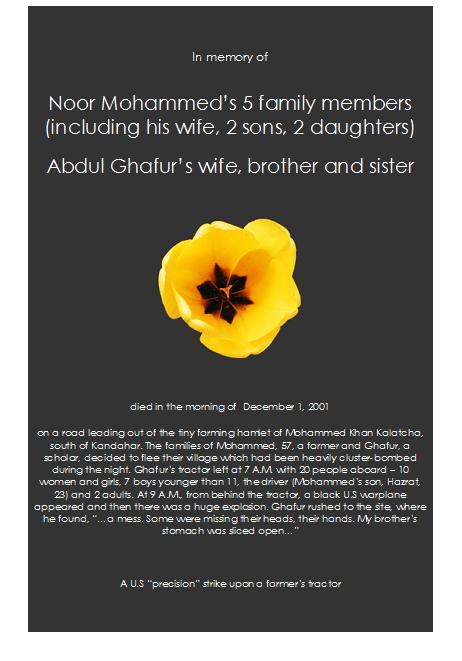
And what did the mainstream U.S press at the time report about these civilian victims of U.S. “precision” air strikes? Absolutely nothing. All the newsprint in America was devoted to the alleged “precision bombing” and the advancing armies of the Northern Alliance (our new-found purchased allies).
According to my body count, 8,022-10,283 innocent Afghan civilians had killed by only US/NATO direct fire during the period October 7, 2001 – December 31, 2009 (the typical ratio of injured to killed civilians is ~1.5). That is, about three Afghan civilians were killed every day since October 7, 2001 by foreign occupation forces. The horror, anger and urge for revenge felt across Afghanistan are in response to this slaughter of innocent Afghans by the United States and to a lesser extent NATO.
Has the slaughter changed when U.S presidents or generals in Afghanistan came and went? A comparison of three Octobers emphatically says, no:
Table 1. Afghan Civilian Casualties Caused by US/NATO Actions in Three Octobers
High count
Low count
Mid-point
October 2007 Bush and McNeill
41
41
41
October 2008 Bush and McKiernan
91
97
94
October 2009 Obama and McChrystal
62
69
65
October 2010 Obama and Petraeus
148
164
156
Source: Afghan Victim Memorial Project data base
In the following pages, I shall focus upon two inter-related issues: (1). the course of America’s Afghan war as actually seen on the ground and (2). the unrelenting Obama/Pentagon efforts to control the public narrative of that war. I shall address neither the fallacies put out by Bush/Obama to justify the Afghan war nor a host of issues analyzed by others which I take as givens providing the context of the raging war. These include:
warlords continue to dominate across most of Afghanistan as confirmed in recent elections;
Afghanistan is either the most or second-most corrupt nation in the world. Karzai’s brother in Kandahar is both a major drug dealer and on the CIA payroll to provide security. Released WikiLeaks documents reveal rampant bribery, graft, etc.;
Numerous national-level Afghan politicians are on the CIA payroll;
much of foreign aid disappears, e.g., U.S funds were used to buy 14 oceanfront villas on the super-luxurious Palm Jumeirah development in Dubai for wealthy Afghans;
that $76.5 billion of the $80 billion committed to Afghanistan has been spent on military and security and much of the remaining $3.5 billion on international consultants;
most of the so-called reconstruction involved high-visibility glamor projects like highways, malls and luxury hotels;
The United States is now spending nearly half a billion dollars a year in an attempt to establish the “rule of law” in Afghanistan. But a new government report suggests it may just be that much more money down the drain;
Afghanistan ranks dead last amongst 163 countries on a food security index;
Between 2004 and 2009, Afghanistan went from being 173rd out of 178 countries to being 181st out of 182 nations on the United Nations’ human development index;
Poverty is unimaginable – 13% of Afghans have access to clean drinking water and 6% to toilets;
Kabul is awash with a NGO mafia notwithstanding that some admirable work has been carried by the likes of OXFAM, DACCAR, etc.;
poppy and hashish cultivation continue (of course, demand creates its own supply) with Afghanistan being the world’s biggest producer of both;
vapid hype about peace talks with ex-Taliban members not involved today in the Afghan resistance, most recently a fake Taliban who made it all the way to Karzai’s palace to “negotiate” underscoring how little the US/NATO know about the Taliban;
sham elections (mostly for Western consumption) with most Afghans disillusioned by electoral politics;
dire poverty amidst ostentatious wealth (villas in Kabul and on the Dubai coast) as Afghan people suffer under a powerful elite tied to Karzai and the U.S.;
Karzai was a puppet from day one and continues to be notwithstanding his periodic outbursts;
Afghanistan ranks worst in gender inequality amongst 25 Asia Pacific nations;
civilians slaughtered by US/NATO are magically transformed into “insurgents”;
The AP, NYT, Washington Post, NPR and PBS continue to serve as mouthpieces of Obama’s Pentagon;
the pitiful state and utter unreliability of the Afghan National Police which is thoroughly infiltrated by the Taliban and much of the Afghan National Army (exactly a replay of the South Vietnamese militaries when Nixon began his doomed Vietnamization strategy in 1970 with a significantly better South Vietnamese puppet army and the inability of the Afghan Army to recruit southern Pashtuns);
U.S and NATO forces rely upon local war lords’ private militias to provide security;
a largely stalled reconstruction effort as a result of de facto Taliban control of 70-80% of Afghanistan where they collect taxes, enforce sharia, provide security, etc.;
periodic pleas for and/or reports about “flipping the Taliban” (Michael Semple, now at the Carr Institute – a flagship of the humanitarian imperialists – pushes that) will never work as it is now a war of national liberation (against US/NATO and its Quisling in Kabul;
and trying to establish a strong, central government in Afghanistan is a fool’s errand.

Where Karzai family and friends spent U.S. aid dollars, Palm Jumeiriah in Dubai (Source: http://www.skyscrapercity.com/showthread.php?t=494048&page=8 )
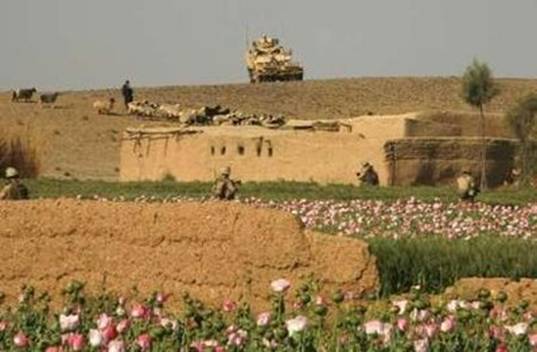
Occupied Afghanistan. U.S. Marines from Lima Company 3rd Battalion, 6th Marines, patrol the area of
Karez-e-Sayyidi, in Helmand province, April 7, 2010 (Photo by Asmaa Waguih, Reuters)
The Course of the Real War on the Afghan Ground (Zero)
I believe that the end of the Afghan war will be determined more by bodies than by politics or deals. The period 2002-6 was an incubating period for the resurgence of the Taliban and its allies. U.S. raids on the ground transformed what had been a fragmented Afghan resistance into a war of national liberation, a matter I have addressed elsewhere in a widely reproduced essay. The rest is history: a trend of soaring Afghan civilian deaths, escalating violence, local military and US/NATO occupation forces deaths and spreading insecurity. The following systems’ chart highlights the essential feedback elements at work in the America’s Afghan war:
Figure 1. Deadly Trade-offs in Afghanistan
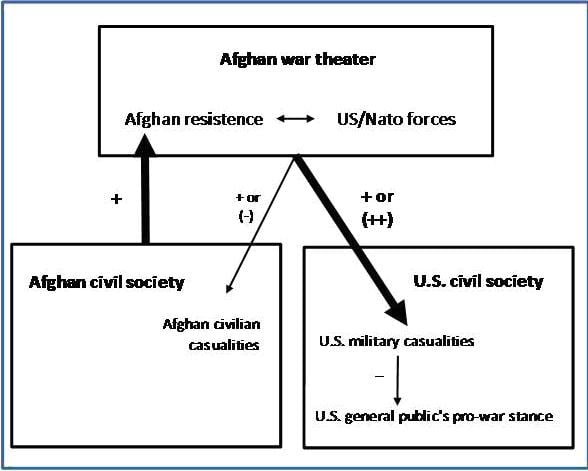
The essential link is that America’s Afghan war causes civilian casualties which, in turn, fuel the Afghan resistance which, in turn, causes more U.S casualties. No link exists between Afghan and U.S civil societies, i.e. rising civilian casualties in America’s foreign wars have never caused the U.S general public to become anti-war. McChrystal’s alleged effort to reduce Afghan civilian casualties (-) was a trade-off for rising U.S military casualties (++) as I demonstrated a year ago. Figure 1 makes an essential point: the United States can pursue its war but the result will be either soaring Afghan civilian casualties or escalating U.S. military deaths. Whereas Gen. Stanley McChrystal opted for the latter, his successor clearly has chosen the former. McChrystal had pronounced the much ballyhooed new metric of civilian casualties. Ackerman writes, “Since Gen. David Petraeus took command of the war effort in late June 2010, coalition aircraft have flown 2,600 attack sorties. That’s 50% more than they did during the same period in 2009. Not surprisingly, civilian casualties are on the rise, as well.” Thus, air strikes are “in” again and the U.S. military is even brazenly bragging about them. But such news is found primarily in the Blogosphere at Wired.com and not to be seen in the New York Times, Washington Post or on PBS/NPR.
Everything indicates more of the same as during 2006-9. As Nir Rosen points out,
“Obama has set an arbitrary deadline of 2014, but his generals are doing the same thing again and again and expecting different results. There is no evidence of progress on any front and every reason to believe next year in Afghanistan will be worse than this year. We mistakenly see Afghanistan through the prism of Iraq. But the ‘surge’ did not reduce violence in Iraq. It was Iraqi social and political dynamics. And none of these elements have their Afghan equivalents. And Iraq remains more violent than Afghanistan. We spend so much time thinking about what we can do in Afghanistan that we ignore the question of whether we even should do it.”
The American war in Afghanistan has followed a demonstrable sequence:
Time period
Offensive thrust
Resulted in problem of
2004-6
Recruit NATO troops
Growing Taliban success
2006-8
Heavy reliance upon air strikes
NATO criticism of civilian deaths
2009
Obama shifts to fewer air strikes, more ground attacks
Rising U.S military casualties
Late 2009
In face of Taliban successes, Obama shifts back to air war
Rising civilian deaths
As the war dragged on foreign forces’ stated goals were scaled back, e.g., from building a democratic nation-building so dear to the humanitarian imperialists to buying time while Afghan police and army forces can be trained sufficiently for the US/NATO to exit. Foreign occupation forces have employed variants of sheer military force and counterinsurgency “win the hearts and minds” tactics. U.S/NATO tactics shifted from setting up forward operating bases in remote areas to shifting back to merely protecting cities and from reliance upon air strikes to favoring attacks by ground forces. The US/NATO forces in 2008-9 had finally been forced to concede that civilian casualties were fuelling the Afghan resistance which led to a change of generals from McKiernan to McChrystal. “General McChrystal says that for every innocent person you kill, you create 10 new enemies.” A recent study by the National Bureau of Economic Research (NBER) found that each time U.S/NATO forces “accidentally” killed Afghan civilians, the resistance forces retaliated with six additional attacks upon foreign forces.
But it goes way beyond mere wounding and killing. The resistance is strengthened by knocking down doors of a home, entering homes, pulling Afghan women be their hair, abductions and beatings, desecration of the Koran, wanton shootings at checkpoints, and simple everyday incidents of western arrogance and insensitivity. A lesser level of Afghan resistance is displayed by NATO’s slick weekly being primarily used in Kabul as food wrapping. The fortnightly Sada-e Azad – Voice of Freedom newspaper packed full of pro-NATO propaganda is put out by German psychological operations taskforce at NATO’s Kabul headquarters and costs 400,000 British pounds to produce 800,000 copies.
Various body counts of civilian Afghan casualties have been published. My numbers of such deaths began rising in 2006 as Table 2 documents. Afghan civilian casualties at the hands of the U.S and NATO steadily rose from 2005-2007.
Table 2. Afghan Civilians Killed by Direct US/NATO Actions (impact deaths)
Year
Low count
High count
Mid-point
2001-2004:
Air war
(Oct 7 – Dec 10, 2001)
Dec 11, 2001 – 2004
4,151
(2,569)
(1,582)
4,856
(2,949)
(1,907)
4,504
2005
408
478
443
2006
653
769
711
2007
1,010
1,297
1,154
2008
864
1,017
941
2009
936
1,087
1,012
Jan – Oct 2010
683
779
731
Cumulative
8,705
10,283
9,494
Note: the data omits most victims of the U.S drone strikes in the border region with Pakistan numbering close to 1,000 deaths.
The Afghan war of national liberation began in 2006. Very little data other than my own was published for the years prior to 2006, though some counts were made of the numbers killed during the early U.S. bombing campaign which I reviewed in August 2002. Interestingly, a study employing a statistical population-based estimating procedure published in 2004 came to almost identical numbers as my own for the same time period. Benini & Moulton calculate 3,994 civilians died from air and artillery bombardments, shooting, and other violence. In other words, the Herold count of 3,620 civilians killed by U.S. air and ground attacks is extremely close to the population-based estimate of Benini & Moulton.
The following Table 3 summarizes various counts of Afghan civilians killed by direct action (air and ground) by U.S and NATO forces from 2006 through the first ten months of 2010. The regular counts are mine and that by the UNAMA. A main difference between the two is that the UNAMA refuses to publish disaggregated data and thereby prevents any fact-checking (or reproducing its data). We are simply asked to believe based upon faith. In addition, since 2009, the UNAMA official in Kabul in charge of such data collection is Ms. Georgette Gagnon, who previously worked with Human Rights Watch (HRW), an organization bankrolled by George Soros and with a long notorious history of over- counting deaths caused by U.S enemies and under-counting those resulting from U.S actions (cases include Iraq in 1991, Kosovo in 1999, and Afghanistan during 2001-2007). UNAMA’s credibility as an impartial broker in Afghanistan is questioned by many in Kabul. In general the UNAMA figures (which include deaths caused by Afghan army and police forces and well as foreign forces) capture a little over half those included in my count (except for 2008), all the while greatly exaggerating deaths caused by the Taliban. Human Rights Watch only published figures for 2006 and 2007. The Afghan Human Rights Monitor (ARM), an independent human rights organization based in Kabul also publishes counts. A graphical summary of the Table 3 data is also included. The Afghan Independent Human Rights Commission (AIHRC) publishes sporadic counts. NATO has reported data on civilians killed by NATO actions during 2008-2010, but the figures are not credible. For example, NATO stated that its forces killed 144 Afghan civilians in the first ten months of 2009, and 160 during the same period in 2010. It baldly asserted that during Jan-Nov. 18th in 2010, 59 civilians were killed in air sorties (fixed wing and helicopters), adding that “civilian deaths were down.” Naturally, this Pentagon “news” was relayed by the Associated Press and picked up by the Washington Post. A quick glance at Table 3 reveals that to be utter nonsense. The well-known research organization, the National Bureau of Economic Research (NBER) released an academic report this year based upon declassified U.S. figures for Jan. 2009 – March 2010. It found 551 Afghan civilians being killed by U.S. forces, as compared to 1,195 in my data base; in other words, the U.S. “misses” over half those killed by its own actions.
Table 3. Various Counts of Afghan Civilian Casualties, 2006 – 2010
2006
2007
2008
2009
2010 Jan-June
2010 Jan-Oct
Herold
711
1,154
941
1,012
350
508
HRW
230
434
–
–
–
UNAMA
(230)
629
828
596
223
ARM
–
–
1,100
921
210
AIHRC
–
–
–
283**
305**
NATO
–
–
–
144***
160***
160
NBER
–
–
–
441 (551*)
Notes: Herold, ARM and the NBER include only Afghan civilians killed by U.S and NATO militaries. Herold data is the midpoint between high and low counts. Human Rights Watch (HRW) counts Afghans killed by foreign forces. UNAMA, AIHRC and the ARM count Afghan civilians killed by pro-government forces which includes the Afghan army and police). NATO includes Afghan civilians killed by its own forces.
*data is for January 2008 – March 2009, I have annualized the NBER data, meaning derived the figure for twelve months in 2009.
**for first 7 months in Afghanistan Independent Human Rights Commission, “Civilian Casualty Figure: First Seven Months of 2010” (Kabul: AIHRC, August 8, 2010) at http://www.aihrc.org.af/2010_eng/Eng_pages/Reports/Thematic/Civilian_Casualities_Jan_Jul31_2010.pdf
***for Jan-Oct
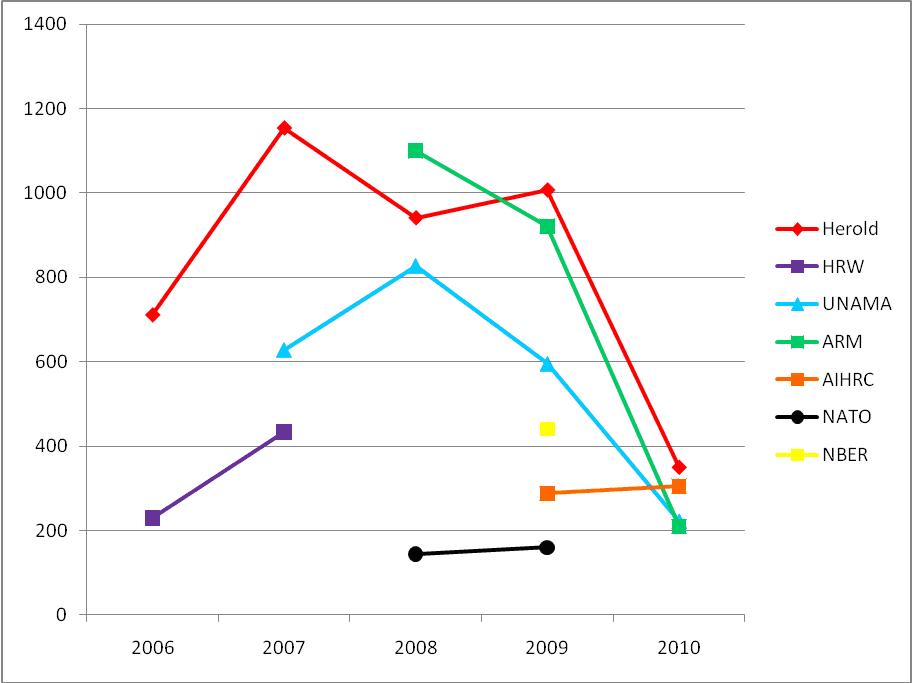
Afghan civilians today die primarily from aerial strikes (fixed wing, helicopters and drones) and ground raids by typically JSOC (Joint Special Operations Command) forces. The latter involve the notorious night-time assassination raids by Special Operations Forces and CIA units which are shrouded in deep secrecy and rarely get reported upon. Under Obama such secret operations known in the military as “man hunters” have sharply increased. The political usefulness is that such secret operations keep the American public in the dark. These CIA or Special Operations Force units in the infamous Project Phoenix mimic the CIA-trained Provincial Reconnaissance Units (PRUs) employed in Vietnam which murdered from 20-40,000 Vietnamese civilians. Once in a while details emerge of the massacres perpetrated by such units, e.g., TF-373 comprised mostly of 7th Special Forces Group members is amply written up in the liberated WikiLeaks documents. For example, on June 17, 2007, launched a mission
…hundreds of miles south in Paktika province. The target was a notorious Libyan fighter, Abu Laith al-Libi. The unit was armed with a new weapon, known as Himars – High Mobility Artillery Rocket System – a pod of six missiles on the back of a small truck.The plan was to launch five rockets at targets in the village of Nangar Khel where TF 373 believed Libi was hiding and then to send in ground troops. The result was that they failed to find Libi but killed six Taliban fighters and then, when they approached the rubble of a madrasa, they found “initial assessment of 7 x NC KIA” which translates as seven non-combatants killed in action. All of them were children. One of them was still alive in the rubble: “The Med TM immediately cleared debris from the mouth and performed CPR.” After 20 minutes, the child died.
Another glimpse was provided when details leaked out about a US Special Forces assault on a party on February 12, 2010 that left a local district attorney, a local police commander and three Afghan women dead (a teenage girl and two of whom were pregnant). At first the U.S. military denied the killings but persistent reports in the British press – not the American media – eventually led to the admission. Dozens of other examples could be provided.
A Scottish aid worker, Linda Norgrove, was killed on October 8, 2010 by a U.S. Special Forces soldier, but the U.S. military initially blamed the death on her Taliban captors, even concocting lurid stories.
The photo below shows one of the 56 Afghan children killed in a midnight raid on April 9, 2009 by US/NATO forces after Obama became Commander-in-Chief. Details on this deadly raid in a village west of Khost city may be found in The Afghan Victim Memorial Project data base.
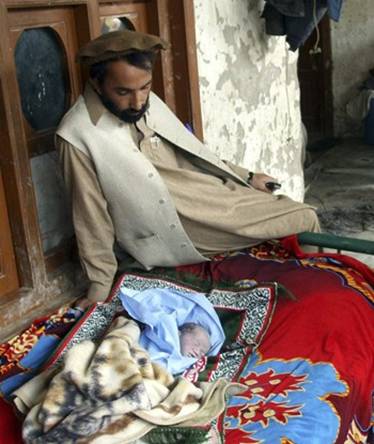
A villager looks at Jannat Gul’s 6-day old infant killed in a midnight U.S ground attack at 00:30 A.M. on April 8/9, 2009 in the district of Gorbaz, near Khost city (photo by Reuters from http://www.daylife.com/photo/08ws2Tief56Zc?q=Khost.
As Obama’s Afghan “surge” unfolds, more fighting and more civilian deaths are certain (as well as renewed efforts by the United States to redefine, omit and suppress reporting upon such). The U.S. mainstream media will mostly be a cooperative partner in the Pentagon’s news management. Many in Afghan see no realistic prospect for peace as long as foreign soldiers remain in Afghanistan and the Taliban have no incentive to compromise when they are in a winning position. An additional 30,000 U.S troops – the Obama surge – means nothing in a country where military experts estimate that ~500,000 foreign soldiers would be necessary to quell the resistance. The simple truth is that the U.S/NATO like the Russians twenty years ago does not have a sufficient number of troops to hold territory. As Sir Rodric Braithwaite, former ambassador to the USSR, put it, both invaders had tactics without strategy.
While much continuity with Bush policies exists, some opportunistic changes in the execution of the Afghan war have been made by Obama. Most are inspired by the aim to better market/spin “the good war” to the American public and especially European publics. For example, under McChrystal U.S/NATO forces were relying less upon deadly air strikes which are 4-10 times more deadly for Afghan civilians than are ground attacks. As a consequence, the monthly total of Afghan civilians killed by US/NATO action declined moderately at the same time as the monthly death toll of occupation forces has risen (Table 4).
Table 4. Monthly Fatalities of Afghan Civilians (killed by US/NATO) Action and of Foreign Occupation Troops Involved in Operation Enduring Freedom, October 2008 – October 2010
(1) Afghan Civilian Deaths
(2) US/NATO troop deaths
Ratio of
(1)/(2)
October 2008
91-97
19
4.8-5.1
November 2008
95-138
12
7.9-11.5
December 2008
41
27
6.8
January 2009
112-120
25
4.5-4.8
February 2009
50
24
2.1
March 2009
36
28
1.3
April 2009
77-82
14
5.8-5.9
May 2009
147-220
27
5.4-8.1
June 2009
119-143
37
3.2-3.4
July 2009
47-56
75
0.6-0.7
August 2009
64-66
76
0.8-0.9
September 2009
99-118
67
1.5-1.8
October 2009
62-69
74
0.8-0.9
November 2009
66
28
2.4
December 2009
57-61
35
1.6-1.7
January 2010
72
43
1.7
February 2010
82-88
52
1.6-1.7
March 2010
28-39
37
0.8-1.1
April 2010
30-35
33
0.9-1.1
May 2010
40-47
51
0.8-0.9
June 2010
68-98
103
0.7-0.9
July 2010
55-61
88
0.6-0.7
August 2010
82-89
79
1.0-1.1
September 2010
78-86
57
1.4-1.5
October 2010
148-164
65
2.3-2.5
Sources: Afghan civilians from my Afghan Victim Memorial Project data base and foreign occupation troop fatalities from ICasualties.org at http://www.icasualties.org/oef/
As a result, the ratio of Afghan civilians killed per occupation soldier death – a measure/metric of the lethality of America’s Afghan war for Afghan civilians relative to that for US/NATO occupation troops – has been falling from above 5 during late 2008 to about 1.3 during March 2009. In 2008, this ratio was 2.9-3.5; 4.4-5.6 in 2007; and 3.4-4.0 in 2006. When McChrystal took over the ratio fell to under 1, however when Petreaus replaced McChrystal the ratio quickly above 1. Combating the Afghan resistance with traditional ground operations is simply much more dangerous for foreign forces than relying upon the more deadly air strikes and night-time assassination raids, both of which have soared under Petreaus. The data for September and October 2010 is grossly underestimated insofar as many civilians killed by U.S. Marines who have replaced the British in the Sangin area of Helmand have not been reported upon though local villagers complain bitterly about such deaths.
Petraeus has discarded the winning-hearts-and-minds counterinsurgency (COIN) approach, replacing it with a deadly trio of blunt force killing – air strikes, drones and Special Operations midnight raids. Such is hardly surprising as when Petraeus took over in Iraq (January 2007 until September 2008) monthly civilian deaths caused by U.S/NATO actions doubled. Night raids by U.S Special Operations forces have risen now to about 200 a month, a five-fold rise since 2009. In 2010, the rate of drone strikes in Pakistan rose seven-fold over 2009. According to Pakistani authorities, 708 people were killed in 51 drone strikes during 2009. The toll for nine months in 2010 has been 600 or more in 75 strikes. Drone strikes’ remain shrouded in official secrecy. U.S. counterinsurgency experts, David Kilcullen and Andrew Exum also cite the 700 figure. Moreover, a strong case can be that besides further fuelling the Af-Pak resistance by” producing enormously high levels of anger and rage against the United States” as even recognized by Kilcullen and Exum, by the standards of international law, drone warfare is illegal.
Obama/Pentagon Efforts at Controlling the Narrative of America’s Afghan War
“During a war, news should be given out for instruction rather than information” — Joseph Goebbels, Adolf Hitler’s propaganda minister
“This is all a war of perceptions” – General Stanley McChrystal
Obama stated that US/NATO forces in Afghanistan were “wagers of peace”…Goebbels could not have done better
America’s propaganda ministers and generals cover-up that the Taliban & Co. are winning in Afghanistan. Neil Faulkner editor of Military Times magazine interpreted the battle of Marjah in Helmand province,
In reality, Marjah is a vaguely-defined area of villages, markets and family compounds. If there are tens of thousands of people, they are spread across 125 sq miles. Marjah was invented because a military operation has to have a clear-cut goal to be deemed a victory. President Obama had doubled the total US troop deployment, but public support was waning. The generals needed a victory, so they created Marjah and planned Operation Moshtarak to capture it. A phantom city was needed because the enemy is a phantom. A task force is assembled and motors into bandit country. If it is too small, it risks annihilation. If it is too big, it finds itself punching the air. A golden rule of guerrilla warfare is that you fight only if you are certain to win. So the invaders of Afghanistan are waging a war against an enemy who is never there. “Suppose we were (as we might be),” wrote T. E. Lawrence, “an influence, an idea, a thing intangible, invulnerable, without front or back, drifting about like a gas? Armies were like plants, immobile, firm-rooted, nourished through long stems to the head. We might be a vapour, blowing where we listed… Ours should be a war of detachment. We were to contain the enemy by the silent threat of a vast, unknown desert …”
Powerful parallels exist between the US/NATO offensives in Helmand and Kandahar now with that of the Soviets in the Panjshir valley in 1982. As the veteran international journalist and writer Edward Girardet noted, during the 1980s
“The Soviets thought they could subdue Afghanistan through brute force, political indoctrination, and bribes. They wanted to put across the notion that their form of government had far more to offer than the jihad embraced by the mujahideen. They lost.”
The much heralded battle of Kandahar promises to be more of the same.
How pathetic to hear U.S. troops whine that the Taliban are too weak to engage foreign forces in a conventional, manly manner and then trumpet loudly that in every pitched battle the Taliban are soundly defeated. Yet, Afghanistan is more dangerous now than it has ever been during the American war according to international organizations and humanitarian groups. Faced with superior force, the resistance simply melts away and then returns when the foreign occupation forces withdraw.
The Taliban have five aces in their hand: a rugged territory which they know like the palm of a hand; the Afghan hatred of foreign domination (not the West); the Afghan belief in taking revenge for a misdeed wrought upon a person’s honor (especially family members); and time). Fourth, William Polk argues that the U.S/NATO display a profound misunderstanding of Afghan socio-political realities which plays into Taliban hands. Polk points to the unique Afghan style of governance, the Afghan understanding of foreign civic action programs (whether Soviet or American), and Afghans’ virulent rejection of a foreign-imposed, corrupt minority regime. Lastly, unlike the U.S military which requires about 7 to 8 support personnel for every combat soldier, the Taliban travel lightly and are extremely mobile. The Taliban are widely recognized to have been able to restore security to the areas under their control, as stated by a resident of Bala Murgab to a Spanish journalist,
“We all know that the Taliban do bad things, that sometimes they’re cruel, but since they arrived in our village, we sleep with the doors open with no fear of being killed or robbed. And that is much more than the government and the foreigners have done for us.”
The situation is far worse as many “…villagers see the foreigners as the main source of insecurity: the presence of foreign troops means IEDs, ambushes and airstrikes…” in the words of a long-time Afghan scholar.
The Taliban’s strategy is to spread out foreign occupation forces across space – the Taliban now have a presence in the north (Kunduz) and in the west (Farah); to lengthen U.S supply lines making them vulnerable; to create just enough uncertainty and danger across Afghanistan so as to prevent any reconstruction; and to kill as many foreigners as possible by primarily using IEDs and suicide attacks. On each count, the Taliban is succeeding. For example, as the American war drags on, the following graph reconstructed from WikiLeaks’ liberated documents clearly confirms the spread of combat from 2004 to 2009. Most recently, the U.S military itself conceded that violence across Afghanistan was at an all-time high and that the insurgency’s geographic reach and sophistication had grown (curiously adding that “security was slowly spreading across the country”). A map produced by the International Council on Security and Development (ICOS) released on September 10, 2009, showed substantial Taliban activity in 97% of Afghanistan. A concrete example is Chak in Wardak province, a scant 40 miles west of Kabul where three years ago the Taliban controlled the district was restricted to the hours of darkness whereas now, as the independent reporter James Ferguson, tells us the Taliban rule day and night. A recent report by aid agencies working in Afghanistan also emphasizes growing insecurity and soaring civilian casualties. A marvelous account of what Taliban-controlled Afghanistan looks like now and what it will look like in the future after the occupation has been provided by The Guardian’s Ghaith Abdul-Ahad.
The Spread of Combat in Afghanistan and Areas under Taliban Control
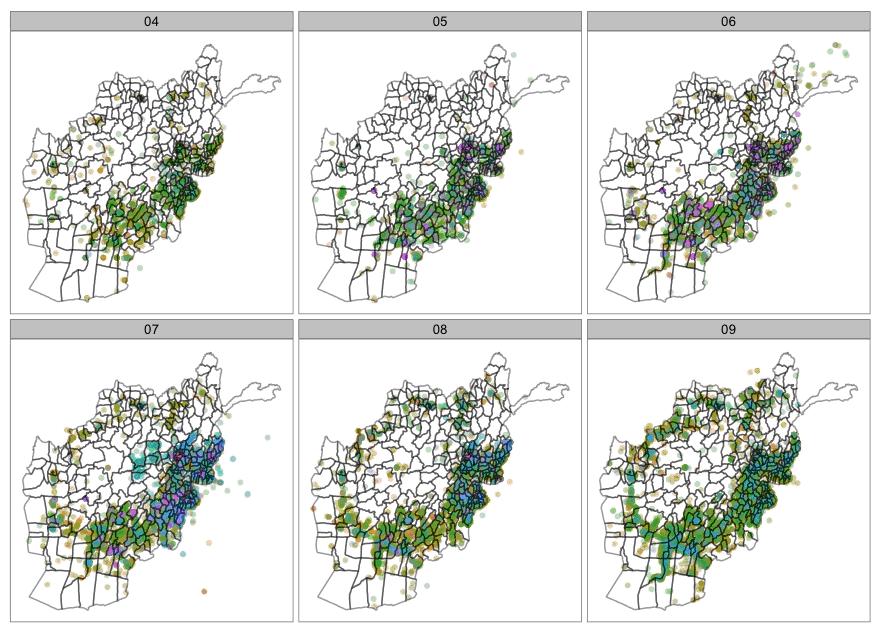
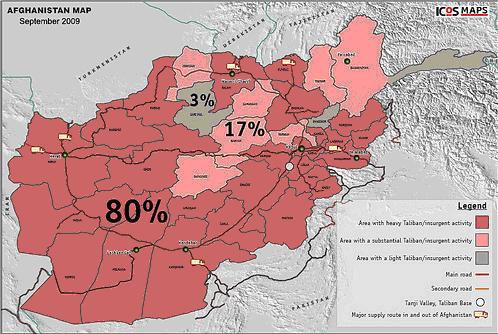
Moreover the Taliban & Co. can attack the capital, Kabul, whenever they so decide. For example, the Taliban quickly learned how to destroy the new MRAP armored vehicle. U.S occupation troop deaths from hostile action have soared since 2007: 2007, 83; 2008, 133; 2009, 266 and to-date in 2010, 411.
How does America seek to set the war narrative, or as I wrote about, sell war as an Edsel? First by spending billions on propaganda. During 2004-2009 the Pentagon’s annual public relations budget increased by 63% to over $4.7 billion. For example, at an abandoned Air Force base in San Antonio (TX), the Pentagon’s “Hometown News” organization publishes glowing stories about the military. In 2009, it planned to put out 5,400opress releases, 3,000 television releases and 1,600 radio interviews – 50% more than in 2007. Some ~$500 million is spent for “psychological operations” targeting foreign audiences. In Afghanistan, funds are being spent to train Afghan journalists to engage in “responsible journalism.” Under the Obama clock, the efforts expended to manage the news coming out from Afghanistan – or to spin the war – have soared as compared to during the administration of his predecessor. Most of the press is content to simply parrot the releases and statements made by US military spokespersons. The U.S. military is more than willing to physically silence oppositional media, as for example with the bombing in April 1999 of Serbia’s State Television and Radio Station building (killing 16 civilians and wounding another 16) and two years later bombing the Al Jazeera office in Kabul in November 2001. As regards combat reporting, the Pentagon profiles reporters, accepting as “embeds” only those deemed by the military as being neutral or positive. The U.S military has also fine-tuned its procedure dealing with Afghan civilians they kill: first say nothing; then when reports being presenting compelling evidence, deny; when more evidence surfaces about civilians dying which cannot be denied, blame the Taliban for the deaths: finally when the presented evidence mounts, minimize the numbers killed and promise an investigation (carried out by themselves).
A typical example of Pentagon and official U.S mainstream failing to report a U.S attack which resulted in civilian casualties was revealed in recently liberated documents by WikiLeaks. A British Guardian report described a midnight raid by Special Forces upon Jaldak, south of Qalat in Zabul Province. The early hour raid resulted in five dead males: an 80-yr old, a 70-yr old, a 30-yr old, a 20-yr old and an 18-yr old, leaving the family without any males. The Jaldak elders maintain the innocence of the dead and three detained, to the point that they refused to bury the bodies and threatened to display them on Highway 1. At the time, the U.S. military issued a news report mentioning that it had killed “five insurgents in a raid in the restive south” in Zabul Province. The report noted that “having moved the women and children to safety, the force entered the buildings, killing five armed militants ….” as relayed by the Agence France-Presse in a wire report of January 9, 2009. A search of Lexis-Nexis reveals one other mention of the Zabul operation. Xinhua General News Service quoted local officials in Zabul who stated that five civilians from one family were killed in a raid by international forces in the wee-hours of Friday. Countless similar examples are presented in my Afghan Victim Memorial Project data base. WikIleaks’ liberated war logs document many cases of how the U.S. military sanitized records of bloodbaths.
Contrary to U.S. military thinking which asserts that “the press heavily reports on civilian casualty incidents…civilian casualty incidents are highly ‘mediagenic’,” a history exists of mainstream U.S media being megaphones for the Pentagon, e.g., Laura King of the Associated Press and the Los Angeles Times being a case in point. I have provided a concrete case study of how the mainstream engaged in immaculate deception about the killing of Afghan civilians on March 24, 2010 and November 23, 2001, in Chagoti Ghar, Khost province.
Three main subterfuges have been used by the U.S and NATO militaries, the compliant corporate media and organizations like Human Rights Watch, to excuse the killing and wounding of innocent Afghan civilians. The first is to express righteous anger over “them” killing civilians intentionally whereas “we” never intentionally target civilians. The second is to assert that the dastardly Taliban and their associates employ civilians as human shields. A third means used by the Pentagon and compliant U.S mainstream media has been to simply omit whenever possible written reports and especially photos of the victims of U.S/NATO military actions (as below), all the while amply publishing stories and photos of Afghan civilians killed by IED’s or suicide bombers (good bodies). In other words, as pointed out long ago by Edward Herman there are good bodies and bad bodies in America’s wars.
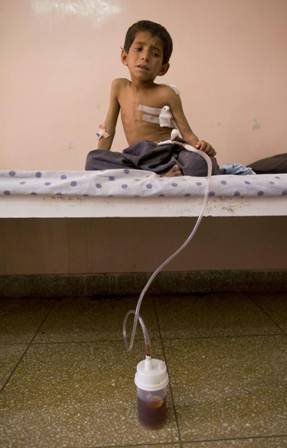
Seven-year-old Attiullah, who was wounded after a bullet entered his back coming out through his chest, sits on his bed at Mirwais hospital October 13, 2009 Kandahar, Afghanistan. According to his grandfather, Attiullah was shot by U.S forces as he was walking in the field near his home in the village of Sangisar, Panjway district watching the family’s flock of sheep. The soldiers apparently shot at a vehicle that was supposedly Taliban and the boy got hit accidently. Mirwais hospital in Kandahar city is the largest regional hospital in the area, supported by the ICRC and the Afghan government, it caters to most of the war wounded in the most hostile part of the country (Source: http://magna.aimoo.com/m/DOGS-OF-WAR/AFGHAN-DIARY-BOOK-FOUR-1-693456.html )
The intentionality argument is often couched in the language of justifiable collateral damage, regrettable but necessary. Since the killing was collateral, it cannot be intentional goes the story. Least-cost considerations (in terms of U.S. military deaths and U.S. dollars) by the US and NATO militaries directly translates into tens of thousands of Afghan civilian casualties. How? During the initial phases of the U.S. bombing campaign but still today, U.S. warplanes dropped powerful bombs in civilian-rich areas with little concern for Afghan civilians. Today, the aerial bombing is more related to close air support called-in by ground forces as a means to defeat the enemy without having to fight him on the ground and likely suffer casualties. The killing of civilians by the United States has long been excused away as “tragic errors.” More significantly, a new term was coined around 1990, collateral damage (which was linked to unintentional), which soon became an essential part of the U.S war narrative. The U.S/NATO war managers dredge out the tired old “intent” argument. As Edward Herman noted,
…it is claimed by the war managers that these deaths and injuries are not deliberate, but are only “collateral” to another end, they are treated by the mainstream media, NGOs, new humanitarians, and others as a lesser evil than cases where civilians are openly targeted. But this differential treatment is a fraud, even if we accept the sometimes disputable claim of inadvertence (occasionally even acknowledged by officials to be false, as described below). Even if not the explicit target, if collateral civilian deaths are highly probable and statistically predictable they are clearly acceptable and intentional. If in 500 raids on Afghan villages alleged to harbor al Qaeda cadres it is likely that civilians will die in 450 of them, those deaths are an integral component of the plan and the clear responsibility of the planners and executioners. As law professor Michael Tonry has said, “In the criminal law, purpose and knowledge are equally culpable states of mind.”
Aerial bombing in the name of liberating Afghans will continue with little regard for Afghan civilians who for the Western politico-military elites (and general public) remain simply invisible in the empty space which is an “increasingly aerially occupied Afghanistan.” The compliant mainstream media perpetuates the myth by serving as stenographer of the Pentagon’s virtual reality. When details of Afghan civilian deaths do leak through the US/NATO news management efforts, a Lt. Colonel at Bagram offers “sincere regrets” or the promise of an investigation and by tomorrow all is forgotten. They are, after all, just Afghans “we” killed. Theirs are bad bodies, not good bodies.
A myth has circulated since the beginning of the U.S. bombing campaign in Afghanistan in October 2001. The myth is endlessly repeated by the U.S. occupation forces, corporate media, the Pentagon, defense intellectual pundits, the Cruise Missile Left, the humanitarian interventionists, and even some in the United Nations: Afghan insurgents hide amongst civilians whom they use as human shields. To begin with, the assertion is never empirically documented but just merely stated as a self-evident truth. Secondly, the implication is that an insurgent or Taliban fighter, resisting the U.S./NATO invasion should stand alone on a mountain ridge, his AK-47 raised to the sky, and engage in a “fair” act of war with an Apache attack helicopter or A-10 Warthog and see who prevails. Thirdly, what is conveniently omitted is that the insurgents have lived in the area, have friends and families in the communities, and that such a local support base is precisely what gives a guerrilla insurgency (along with knowledge of the local terrain) its classic advantage. Such local connection means that the insurgents will (unlike the US/NATO occupation forces) go to great lengths to not put local people in danger.
Time magazine produced a strong, timely piece of gruesome propaganda when it put the face of a young Afghan girl with her nose cut off “by the Taliban” on its magazine cover. At the time, the Taliban denied having done so, but the mainstream media ignored the denial. We now know that the girl was punished by her father for running away from her abusive husband numerous times, as reported by the independent Afghan Independent Human Rights Commission. Any retraction from the likes of Time, the Associated Press, the Washington Post, etc.? Of course not.
The mainstream war narrative directed at Euro-American public resembles a sea of lies: Obama’s mega and mini lies, NATO lies, UNAMA lies, NBER academic lies, Associated Press lies, mainstream media lies, and Lara Logan (of CBS 60 Minutes) lies. The sea is stocked with lies of omission and of commission employed to construct the war narrative. A sample listing of such instruction not information follows though each merits an extended discussion:
• Announcing the killing of “important” Taliban or Al Qaeda leader alleged to have been eliminated by a drone in the Af-Pak border region but who then resurface weeks or months later (the multiple lives of resistance leaders);
• Proclaiming victory in taking over (the fictional) city of Marjah a success then and Kandahar now and so many other futile “surges” during the past nine years (of areas allegedly cleared but which are then re-occupied by the Taliban);
• Misrepresenting U.S human cost of war (let alone the carnage in Afghanistan) by hiring mercenaries (including a staggering number of private contractors- by late 2009, 64,000 U.S troops and 104,000 contractors shared the Afghan battlefield, the highest ratio of contractors to military personnel in U.S. history) and Green Card soldiers), outsourcing combat to lackey nations (e.g., most recently Slovakia, Czech Republic even Mongolia);
• Enemy body counts solemnly proclaimed at Bagram or in Kabul reminiscent of Saigon’s “Five O’clock Follies”;
• Widespread torture and secret imprisonment-= Gulag Nation (see Omar Khadr case) with impunity; somehow the CIA torture tapes just disappeared and no one is held accountable); far less transparency at Obama’s secret penal colony, Bagram, and hidden CIA bases in Afghanistan where torture is no-doubt routine;
• Probably continuing rendition flights which will be revealed 3-10 years from now;
• Hiding the fact that all too many US soldiers from General “mad dog” Mattis who famously proclaimed he enjoyed killing to the Stryker Brigade boys who took photos posing with dead Afghan civilians and the trigger-happy helicopter pilots, enjoy killing enemy Afghans having growing up with violent video games;
• Massive Pentagon propaganda effort to magnify or invent civilian deaths caused by resistance side and to completely suppress reports of those killed by US/NATO forces;
• Trumpeting on-going discussions with “moderate” Taliban (truth = with ex-Taliban now dimly viewed by the fighting Taliban) when the real Taliban have repeatedly stated that no negotiations will take as long as Afghanistan is an occupied country:
• The assiduous use of language to sell war (e.g., the resistance is terrorism), foreign peacemaking forces not occupation forces, etc.;
• Pursuing government secrecy with a zeal greater than even George W. Bush;
• Hotel journalism versus that by real independent, unembedded journalists like Jerome Starkey (The Times), Chris Sands (The National), David Lindorff (CounterPunch), Ghaith Abdul-Ahad (The Guardian), or James Ferguson (The Independent). An important element used by the US/ NATO militaries is to rely upon embedded journalists who provide accounts favorable to these militaries (this is NOT independent journalism). My favorite example of such an embedded mouthpiece for the US military is CBS’s 60 minutes’ Lara Logan, a great fan (nay, groupie) of U.S Special Forces who make the news lady breathless. Other stellar exemplars of such toady journalists are Laura King and Jason Strasziuso;
• The American media regularly offers the pabulum that the Taliban are a few dollars a-day rented fighters when the truth is that they are a disciplined, well-trained and equipped fighting force focused upon seizing power either by conquest or by negotiation;
• Failing to note that there are now at best 50-100 Al Qaeda cadres/fighters in all of Afghanistan;
• The different ways in which the American media and the European media reported upon the massive trove of information released by WikiLeaks on July 25, 2010. Lara Logan of CBS focused only upon atrocities committed by the Taliban, which amounts to propaganda not journalism;
• And generally, a discourse about politics as a Debordian spectacle.
The vehemence with which the Obama administration seeks to control the war narrative is revealed by the fierce reaction to the posting by WikiLeaks of internal war documents.
Each of these warrants extended discussion. Let me focus upon images and language in service of America’s war. Western mainstream press delights in printing photos of civilians especially children hurt or killed by Taliban attacks as for example the one below from Yahoo!News. But do we ever see photos of the victims of US/NATO attacks? Of course not even though such photos are taken and posted outside the U.S. (as for example in my data base containing over 1,000 photos of Afghanistan under US bombing and occupation).
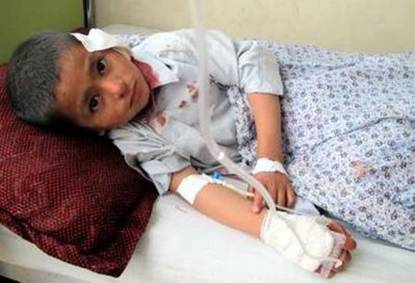
Headline: “Wounded Afghan boy lies on hospital bed”
A wounded Afghan boy lies on a hospital bed in the Emam Sehab district of Kunduz province November 13, 2010. A bomb hidden on a motorcycle killed at least eight civilians and wounded 18 in northern Kunduz province, a district official said. The bomb apparently targeted a militia leader, who was among those killed. Source: http://news.yahoo.com/nphotos/slideshow/photo//101113/ids_photos_wl/r3379912763.jpg/;_ylt=Ak8_D5j0fuKDL3H.fiPuMeQBS5Z4 photo by a stringer for Reuters.
Contrast the above with these photos from RAWA. Such photos rarely appear in the U.S., but do in Europe, the Middle East and South Asia. Such photos will not be published in America as they depict “bad bodies” which might make the public uncomfortable. Analysis of mainstream U.S. news-magazine photo coverage during the early years of the Afghan conflict clearly revealed that the printed photographs offered prompts for the prevailing government version of events, e.g., our troops don’t kill and maim.
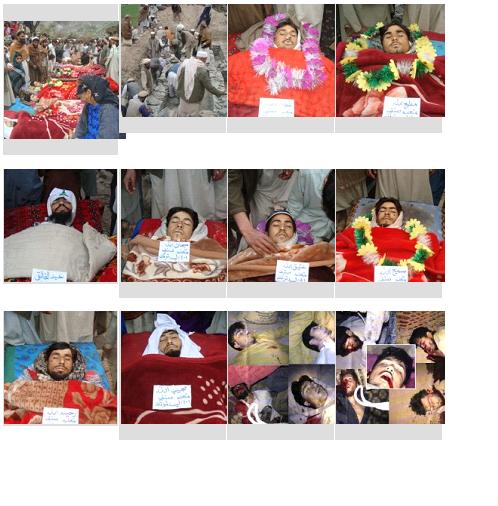
Headline: “U.S Special Forces brutally kill 10 Afghan civilians in Narang district”
On Dec.27, 2009, at around 2:30 of mid night, US Special Forces raided Ghazi Khan Ghondi village of Narang District in Kunar province of Afghanistan. They enter the civilian houses and kill ten civilians, among them eight were school boys, one a poor farmer and a 12-year-old rancher. They all have been shot in the head. Although the US occupation forces denied any involvement, but Kai Eide, special UN representative announced in a press conference that the “international forces” were engaged in the incident and “a preliminary United Nations investigation has found that eight students were among 10 Afghan civilians killed in Kunar province.” Further photos and details at “US Special Forces Bruttaly Kill 10 Afghan Civilians in Narang – Photo Gallery,” RAWA (January 2, 2010) at http://www.uruknet.info/?p=61746
Language is selectively employed to construct the Obama, Pentagon, mainstream media war narrative. Almost every wire service report by the Associated Press includes “…the Taliban regularly exaggerate casualties caused by their attacks.” A festival of Orwellian language is deployed by the Pentagon and Commander-in-Chief Obama. Obama was described as engaging in Operation Redefinition (by Jon Stewart on March 31, 2009). Obama simply redefines the old Bush policies and tactics in Afghanistan which largely remain in place, in his Operation Redefinition.
On December 3, 2010, redefinition was upped another notch by Obama who snuck into Afghanistan for a four-hour secret visit at the U.S. base, Bagram, where clad in a bomber jacket he proclaimed the U.S. was winning the war, amidst overwhelming contrary evidence. Losing is winning and U.S. troops in Afghanistan are in ObamaSpeak “wagers of peace.”
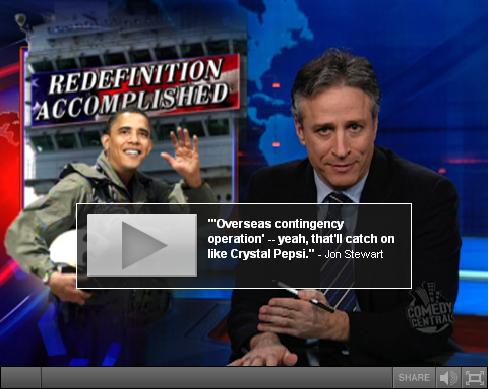
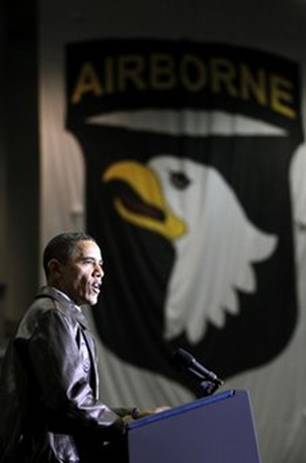
The war narrative regularly employs such phrases as “Taliban infested area” (why not rewrite as “foreign occupation force infested area”?). The use of the word “terrorist” for a military opponent is systematic, as is use of the adjective “peacekeeping” or far worse Obama’s “wagers of peace” instead of occupation forces. Combat troop increases are now labeled under Pentagon-Speak as “combat enablers.” When a US/NATO helicopter is shot down the narrative is a helicopter made a “hard landing”, instead of being shot down. Media spokespersons from the opposing warring side are identified differently: a Taliban “mouthpiece” versus a “NATO spokesman.” The persons fighting the foreign invaders are “terrorists” not resistance fighters though of course in 1980’s the Afghans fighting the Russian invader were called “freedom fighters.”
The usual western mantra is “The Taliban often exaggerates the details of attacks and play down the numbers of their own casualties.” But let’s rewrite the above substituting Americans/NATO for Taliban.
Another standard mantra is the “Insurgents continue their indiscriminate killing and wounding of innocent civilians despite their leaderships guidance,” said U.S. Army Col. Rafael Torres, International Security Assistance Force Joint Command Combined Joint Operations Center director. “Our thoughts and concerns are with the families during this difficult time.”
As Afghan civilian deaths rose, the U.S/NATO says, “…Sorry.”
Conclusion: The Politics of What Matters and Where
William Dalrymple argues the comparison of Afghanistan today is less with Vietnam and more with Great Britain’s Great Game of 1839-42. In the end, the main determinant of the course of America’s Afghan war will be bodies. The increasing number of Afghan bodies matters and fuels the resistance, resulting in what Anatol Lieven of King’s College (London) aptly observed, Afghanistan
“is becoming a sort of surreal hunting estate, in which the U.S. and NATO breed the very terrorists they then track down.”
The American public (except for the old left, the Unitarians and Quakers, a couple other progressive churches, folks at the Brave New Foundation, RAWA’s American supporters, and many on the libertarian Right) does not (and has never) care(d) about civilians killed by US military. But for liberals, Obama can do no wrong. They only care about U.S troop deaths. G.W Bush knew this early on – see his banning of photos of dead U.S. military personnel at Dover Air Base. Official U.S military bodies (killed or injured) matter strongly in the United States. Afghan bodies count for nothing with the American public. Every effort will be undertaken by Obama/Pentagon to minimize US domestic political opposition to foreign war-making. This began in the post-Vietnam era with the shift from a drafted army to one relying upon professional “volunteers,” a narrow sliver of the country’s population. In recent mid-term elections in the United States, only 6.5% of voters mentioned the Afghan war as being of concern.
It’s all about controlling the US war narrative, something very different from the truth. A first successful ploy was to entice the NATO countries into fighting in Afghanistan in 2004. The count of war dead by nationality shows that NATO stalwarts like Britain, Canada and Holland did a disproportionate amount of the heavy lifting. Some NATO countries understood the ploy and limited their contribution to non-fighting areas at the time, e.g., Germany and Spain. But as the war grinded on and NATO country publics turned decidedly against it, Bush first and Obama later sought creative new ways to minimize officially acknowledged U.S. military casualties. Such measures included: massive reliance upon private contractors (privatizing American war-making) and assorted Rambos (de facto mercenaries); ramping up the use Green Card soldiers; and begging for troops from other nations. The use of contractors is especially convenient as these are not reported as U.S. military casualties.
Most twentieth century counterinsurgency wars have failed (the two exceptions being the Americans in the Philippines and the British in Malaya). The resistance wins because it knows the home territory and the invader cannot overcome the “foreign invader” label. History carries some potent lessons.
General Sergei Akhromeyev, commander of the Soviet armed forces, address(ed) the Soviet Politburo in 1986. “There is no piece of land in Afghanistan that has not been occupied by one of our soldiers at some time or another. Nevertheless much of the territory stays in the hands of the terrorists. We control the provincial centres, but we cannot maintain political control over the territory we seize.”… General Akhromeyev demanded extra troops – or the war in Afghanistan would continue “for a very, very long time”. And how’s this for a quotation from, say, a British or US commander in Helmand today? “Our soldiers are not to blame. They’ve fought incredibly bravely in adverse conditions. But to occupy towns and villages temporarily has little value in such a vast land where the insurgents can just disappear into the hills.” Yes, of course, this was Gen Akhromeyev in 1986.
All the while Al Qaeda laughs as 9/11 was primarily about weakening the U.S economy, that is, hastening America’s imperial overstretch. Recall Ernesto Che Guevara who close to a half century ago pushed for “One, Two, Three, Many Vietnams.” Abu Mus’ab wrote,
“No reasonable person can deny the United States’ military, economic and technological power… [However, both the U.S.’s] technological research and its military forces depend on the economy. [Consequently], the destruction of its economy will cause the U.S. to disintegrate, collapse, and disappear, just like the Soviet Union.”
A ten year Afghan quagmire serves that end.
The American war in Afghanistan will end after NATO country militaries withdraw. This process began with the Dutch in 2010, the Canadians in 2011 and will accelerate in 2011. No amount of Croatian, Mongolian, Georgian and other such troops can replace the old NATO contingents.
In the end bodies tell the story, America’s lost war in Afghanistan will cease, cut by the scissors of Afghan bodies and mounting U.S. military bodies.
Notes
1. Jason Dietz, “US to Pump Thousands of ‘Combat Enablers’ into Afghanistan,” Antiwar.com (September 15, 2009) at
http://news.antiwar.com/2009/09/15/us-to-pump-thousands-of-combat-enablers-into-afghanistan/
2. See for example at http://news.yahoo.com/s/nm/20101113/wl_nm/us_afghanistan_4 by Reuters, November 13, 2010 at 4:18 AM ET.
3. Julius Cavendish, “Afghanistan War: As Civilian Deaths Rise, NATO Says, ‘I’m Sorry’,” Christian Science Monitor (February 23, 2010) at
http://www.csmonitor.com/World/Asia-South-Central/2010/0223/Afghanistan-war-As-civilian-deaths-rise-NATO-says-Sorry
4. Dalrymple, op. cit.
5. in his “Dream of Afghan Democracy is Dead,” Financial Times (June 11, 2008)
6. See for example, Ron Paul, “The Cycle of Violence in Afghanistan,” LewRockwell.com (August 10, 2010) at http://www.lewrockwell.com/paul/paul688.html and “Instead of Bombs and Bribes, Let’s Try Empathy and Trade,” Antiwar.com (October 5, 2009) at http://original.antiwar.com/paul/2009/10/05/
7. Justin Raimundo, “With Obama in Office, Liberals Learn to Love War,” Antiwar.com (April 20, 2009) at http://www.amconmag.com/article/2009/apr/20/00020/
8. See Eric Margolis,”Rent-a-Rambos,” LewRockwell (Marc 23, 2010) at http://www.lewrockwell.com/margolis/margolis184.html
9. Ivan Eland, “Why Most Counterinsurgency Wars Fail,” The Independent Institute (November 11, 2009) at http://www.independent.org/newsroom/article.asp?id=2659
10. Fisk, op. cit
11. E. Alsech, “‘The Battle…Is Economic Rather than Military ‘ An Economically Oriented Concept Emerges in Islamist Discourse,” MEMRI Inquiry and Analysis Series No. 387 (September 11, 2007) at
http://www.memrijttm.org/content/en/report.htm?report=2371.
See also This past July 1st, Mike Scheuer elaborated upon why America lost its Afghan war, see Michael Scheuer, ”Why the West Lost Afghan War,” The Diplomat (July 1, 2010) at
http://the-diplomat.com/2010/07/01/why-west-lost-afghan-war/
12. “ The mythology of third world revolution, symbolised everywhere by the image of Che, came to its climax as Guevara was wandering, sick and lost, in the Bolivian rainforest. Che’s call to the Tricontinental Conference in April 1967 to create ‘One, two, three many Vietnams’ was a brilliant slogan. His political practice, however, was unable to deliver on its promise. Che’s death was its epitaph. Within a year Castro announced Cuba’s absorption into the Soviet camp and abandoned the guerrilla war strategy without a fanfare – and only Douglas Bravo, the Venezuelan revolutionary, denounced it as an act of betrayal” from Mike Gonzalez, Feature Article: The Lost Generation – the Life and Politics of Che Guevara,” Socialist Review 212 (October 1997) at http://pubs.socialistreviewindex.org.uk/sr212/gonzalez.htm

